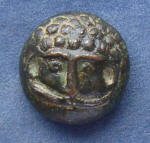

Click on links for information on Parthian science and engineering:
| Parthian architecture was characterized by the use of sun-dried or kiln-baked bricks, with vaults to roof the buildings. The Parthians developed the iwan, an open-fronted vaulted hall. They are often covered with carved stucco reliefs, some of the finest examples of which are found at Uruk and Ashur. The palace at Ashur has the earliest example of four iwans opening onto a central square. This form of architecture supplanted Hellenistic styles in Iraq and Iran, and was adopted by the Sasanians and continued to set the model for architecture in the early Islamic period. While glaze was used on vessels and even coffins in the Parthian period, little architectural evidence exists of glazed brick. On vessels and other glazed items, turquoise and light green glaze were the most popular colors. Fresco painting was more popular for the decoration of buildings. An architectural form known as ogee to Europeans and zigzag molding to Iranian architects, is of Parthian origin. Parthian architects constructed palace walls with cut stones. They also used stucco to render the walls. The themes of their stuccos were geometrical lines and floral designs. In stone carving, a popular theme was equestrian statues in relief. |
| Astronomy was evidently an important part of Parthian science, primarily for calendar purposes. In addition, the Parthian king of kings was called the "brother of the sun and the moon," perhaps indicating the importance of astrology to the Parthians. The crescent moon and star motifs appear on many coins adjacent to the king's portrait. |
 The jar from the Parthian period (roughly 250 B.C. to A.D. 250) was first described by German archaeologist Wilhelm Konig in 1938. It is unclear if Konig dug the object up himself or located it within the holdings of the museum, but it is known that it was found, with several others, at a place called Khujut Rabu, just outside Baghdad and is composed of a clay jar with a stopper made of asphalt. Sticking through the asphalt is an iron rod surrounded by a copper cylinder. When filled with vinegar - or any other electrolytic solution - the jar produces about 1.1 volts. The jar from the Parthian period (roughly 250 B.C. to A.D. 250) was first described by German archaeologist Wilhelm Konig in 1938. It is unclear if Konig dug the object up himself or located it within the holdings of the museum, but it is known that it was found, with several others, at a place called Khujut Rabu, just outside Baghdad and is composed of a clay jar with a stopper made of asphalt. Sticking through the asphalt is an iron rod surrounded by a copper cylinder. When filled with vinegar - or any other electrolytic solution - the jar produces about 1.1 volts. German researcher Dr. Arne Eggebrecht has actually made a copy of the battery and gold electroplated several items. He believes that many of the gold items in museums are actually gold plated silver. The counterbalance to the claims of electrical use are contained in the very scholarly article "Electricity: Generation or magic? The analysis of an unusual group of finds from Mesopotamia" by Emmerich Pászthory in History of technology : the role of metals (MASCA research papers in science and archaeology, v. 6, 1989, pp. 31-38). He discusses the magical meaning of metals in earlier eras and suggests these objects were containers for blessings/incantations written on organic material. Three web sites describe these jars: Les piles électriques de Bagdad Museum of Unnatural Mystery Smith College Museum of Ancient Invention |
|
In the literature, there appear to be no mentions of Parthian weight standards nor examples of weights from the Parthian era. In June 2005, Simmons Gallery offered at auction a possibly unique item tentatively identified as a "Parthian weight". With their kind permission, lot 22 of their mail bid sale 34, Weights and Scales, is illustrated here in the hope that a positive identification, additional information, or a correction of details can be made. Click on the images to enlarge. |
 |
Description: Lot no 22: Tetradrachm, Round bronze weight with a facing face rev. flat. 20mm. 16.35gm. The weight is very close to the weight of the early Parthian Tetradrachm coins. Stylistically this looks Parthian but we have been unable to track down any comparable piece. Attractive brown patina. The Parthians ruled Persia from c 200BC-200AD. This weight came out of the antiquities trade in London. The specific provenance is lost but the find site is reportedly in Greater Iran. |
|
| No equivalent pieces have been found. The Department of Coins & Medals at the British Museum have seen this piece and they have not seen the like elsewhere. The metrology is fairly conclusive: it does look like a weight, has the approximate weight of a tetradrachm, is ancient, and is consistent with Parthian design. If you have information on this or similar items, please inform Chris Hopkins by email. |
||
This page last updated 23 Feb 2021